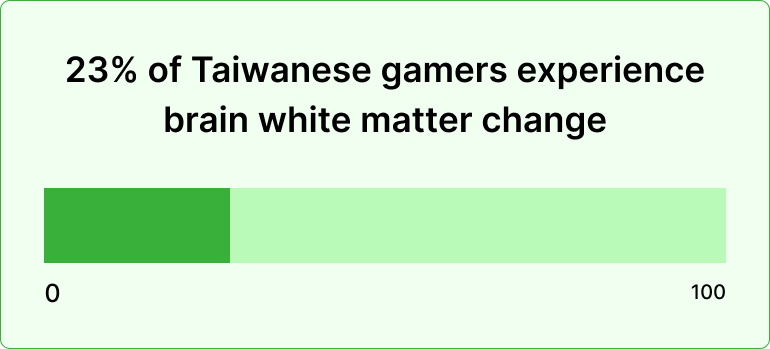The complete monitoring experience for your phone
Get XNSPY and start tracking calls, texts, multimedia, locations and more on any phone!
Get Started Now Live DemoYou come home from a long day of work, looking forward to the quietness and peace. Instead, you find your child glued to a gaming setup – unshowered and sleep-deprived, who has been eating junk and pushing buttons on his gaming setup for a week straight.
It might sound extreme, but scenarios like this reflect the reality for many families. These are one of the many symptoms of severe video game addiction, and it is more common than you might think. So, it is important to stay aware of the erosion that video games are capable of.
To address it, you first need to understand the scale of the problem. That is why we have researched and gathered 60 latest video game addiction statistics, along with prevention tips, to help you recognize the warning signs and take action before it escalates.
Why are Video Games Addictive
For many parents, it can be difficult to understand why a child chooses to spend hours in front of a screen instead of doing almost anything else. The reality is that video games are deliberately designed to keep players engaged for as long as possible. Here’s how they achieve that.
1. They Train Reward Learning
Games use variable-ratio rewards, such as loot drops, critical hits, or rare skins. Because the reward is unpredictable, the brain’s dopamine system reinforces the behavior strongly, making “play again” a natural response.
2. They Satisfy Core Psychological Needs
Video games are built to deliver competence (progression, level-ups), autonomy (meaningful choices), and relatedness (cooperative play, guilds). These needs are deeply motivating and keep players coming back.
3. They Create Flow
Well-designed games balance challenge with player skill. This “flow state” is highly rewarding and encourages extended play sessions to maintain that feeling.
4. They Build Habit Loops
Cues like notifications and daily quests lead to a routine (quick gaming session) followed by a reward (XP, streaks, or in-game currency). Over time, this becomes a deeply ingrained habit.
5. They Leverage Loss Aversion and FOMO
Limited-time events, expiring rewards, and seasonal rankings create urgency. The idea of “missing out” pushes players to log in even when they hadn’t planned to.
6. They Add Social Pressure
Many games require teamwork in raids, ranked matches, or clan activities. Children may feel a responsibility to show up for their team, extending playtime beyond what is healthy.
7. They Use Near-Miss and “Almost There” Effects
Progress bars close to completion, narrow defeats, or “just one more win” moments encourage players to keep trying until they succeed.
8. They Personalize Engagement
Modern matchmaking and AI systems adjust difficulty, pacing, and even rewards to each player’s performance, which keeps engagement consistently high.
9. They Regulate Mood
Games offer immediate achievement, distraction, and stress relief. This can turn gaming into a default coping mechanism for boredom or negative emotions.
10. They Lower Friction
Cross-platform play, cloud saves, and instant matchmaking remove barriers to re-entry. This makes it easy to start another session anytime.
11. They Create Sunk Costs
Time spent earning items, building characters, or progressing in rankings increases the psychological cost of quitting, which makes stopping harder.
12. They Monetize on the Same Levers
Loot boxes, gacha systems, and microtransactions combine reward unpredictability with spending prompts, which can intensify play for some children.
Handpicked Blogs Just For You
⛔ 99+ Teen Mental Health Statistics & Facts
🧬 Gen Alpha Slang: 99+ Most Popular Terms & What They Mean
⚠️ 79+ Screen Time Statistics for Kids and Teens + Tips to Reduce It
🎵 TikTok Slang: 125+ Words You’ve Probably Heard But Never Understood
General Gaming Addiction Statistics

1. 50% of gamers admit to being addicted to video games.
2. An estimated 3.4 billion individuals are engaging in video gaming around the world.
3. 1 in 10 gamers play games for more than 12 hours a day.
4. 22% of gamers have lost sleep because of playing video games.
5. 15% of gamers have regularly skipped meals to play video games.
6. Around 3.3% of professional gamers around the world have a gaming disorder.
7. The gaming market is expected to grow by 12.8% by 2030.
8. 67% of all gamers belong to the Caucasian ethnicity.
Video Gaming Addiction Statistics by Age
Children

9. 14% of addicted children show signs of aggression.
10. Gaming addiction is associated with increased risk of obesity in 22% of affected children.
11. Eye strain and headaches affect 33% of frequent child gamers.
12. 8.5% of youth gamers aged 8-18 in the U.S display signs of addiction.
13. 86% of parents believe their kids spend too much time gaming, expressing concerns about sleep and social interaction.
14. 1 in 5 children has attempted to cut back on gaming and found it difficult.
15. Children who game for 3+ hours daily are at higher risk of sleep disruption.
16. The average age when children start gaming is now 6 years old.
Teens

17. Nearly 25% of teens hide their gaming activity.
18. Up to 20% of addicted teen gamers report that online gaming relationships feel more important than real-life friendships.
19. Teenagers addicted to online multiplayer games are 37% more likely to experience online bullying or harassment.
20. More than 90% of teenage boys play video games regularly.
21. Teens who game 3+ hours/day have a higher risk of anxiety and depression.
22. 19% of addicted teens report feeling angry or irritable when unable to play.
23. Online multiplayer games are linked to higher rates of teen gaming addiction due to social pressure and competition.
24. Addicted teens often use gaming to escape emotional problems or stress.

Don’t Let Gaming Take Over Real Life
Support healthy habits by tracking gaming activity with XNSPY.
Adults

25. Gaming addiction leads to a 35% increase in social anxiety.
26. Adults addicted to video games are 2.6 times more likely to report moderate to severe depression.
27. 1 in 10 adults with gaming addiction admit to skipping work or calling in sick to continue gaming.
28. Men aged 18-35 are the most affected demographic for adults.
29. The average age of a gamer is now 33 years old, and many continue playing heavily into adulthood.
30. Less than 10% of gaming addicted adults seek professional help.
31. 55% of adults with gaming addiction admit to gaming to escape real-life stress.
32. More than 20% of gamers aged 18-24 report prioritizing gaming over personal hygiene or meals
Interesting Facts About Video Game Addiction

33. 90% of video game addicts know about their habits.
34. Games that include loot boxes and microtransactions have been linked to compulsive behaviors, similar to gambling.
35. Video game addiction shares neurological similarities with substance abuse, activating the same reward centers in the brain that respond to drugs.
36. Video games with in-game rewards increase the risk of compulsive play by up to 30%.
37. Problematic gaming behavior increased by 50% during the COVID-19 pandemic.
38. Women make up about 41% of the adult gaming population, but are less likely to report addiction.
39. “Gaming Disorder” is officially recognized by the World Health Organization as a mental health condition.
40. Some players have died from extreme gaming binges, especially in internet cafes, after playing nonstop for over 24-72 hours.
Global Gaming Addiction Facts

41. A study in Taiwan found that 23% of teenage gamers showed changes in brain white matter associated with impulse control.
42. In the United Kingdom, 1 in 10 parents have reported their child has missed school due to gaming.
43. The South Korean government has implemented “Shutdown Laws” banning under-16s from playing games between midnight and 6 AM.
44. China has restricted minors to 3 hours of gaming per week to combat addiction.
45. A Dutch study indicated that gamers addicted to online multiplayer games were three times more likely to develop social isolation compared to casual players.
46. In Brazil, mobile gaming is the most common platform, contributing to addiction due to accessibility.
47. Russian health programs have started including media literacy to address the issue of gaming addiction.
48. Surveys in Japan found that 13.7% of Japanese high school students exhibit signs of gaming addiction severe enough to interfere with school and family life.

Pause the Game Loop with XNSPY
Take control of gaming habits before it starts controlling your kids.
Statistics on Video Game Addiction in America

49. 8.5% of American kids exhibit signs of video game addiction.
50. Only 28% of U.S parents report consistently enforcing screen time limits for gaming.
51. Gaming addictions in the U.S are more common in lower-income households, where access to other recreational activities is limited.
52. U.S psychologists have reported a 20-30% increase in therapy cases involving problematic gaming behavior.
53. 80% of American households own at least one gaming device, increasing accessibility and potential for overuse.
The Roots of All Addiction to Video Games
54. 94% of addicted gamers say they play to relieve stress.
55. 70% of players are motivated by a desire for achievement and in-game rewards.
56. 81% of gamers play because it gives them a sense of control or mastery lacking in real life.
57. 60% of addicted gamers say they feel more successful in games than in real life.
58. Personalized avatars and customization features increase attachment and time investment in games.
59. 40% of college students with gaming addiction say they began excessive gaming after experiencing a major life stressor, such as parental divorce or academic failure.
60. In households where parents use screens excessively, children are 2.9 times more likely to develop problematic gaming habits.
How to Tackle Video Game Addiction Effectively: 4 Strategies That Work
Dealing with video game addiction isn’t just about pulling the plug on the console. You need to know what actually works. Here are 4 tips that will help your child break unhealthy patterns and regain balance.
1. Use XNSPY
XNSPY is a powerful monitoring tool designed to help parents manage and understand their child’s video game usage. With it, you can see exactly how much time your child spends on games, track which titles they’re playing, and get a clear picture of when gaming starts to interfere with school, sleep, or social activities.
It’s no mystery that excessive gameplay among kids and teens can lead to poor academic performance and social withdrawal. XNSPY lets you step in before it reaches that stage. By remotely blocking gaming apps or locking the device, parents can take timely actions to encourage healthier digital routines.
XNSPY’s screen recording and keylogging features also give insight into what’s happening inside games, especially online multiplayer ones with open chat systems. Many of these spaces are unmoderated, meaning children can be exposed to inappropriate language, cyberbullying, or contact from strangers. XNSPY helps you see exactly who they’re interacting with and what’s being said.
By having this visibility, you can address the root causes of excessive play – whether it is peer pressure, stress relief, or simply poor time management – and guide your child toward a balanced digital routine. XNSPY turns monitoring into meaningful action by giving you both oversight and control.
2. Set a Strict Time Limit for Gaming
Experts in children’s health recommend that school-aged kids spend no more than two hours a day on screen. With TV, phones, homework, and video games, screen time adds up fast. If you’re concerned about how much time you or your child spends gaming, try setting a daily limit of 30 minutes to an hour.
Time their gaming or encourage them to use alarms so that they can develop the responsibility to stop playing. Aside from this, taking part in physical activities can help balance screen time and support better health.
3. Remove Gaming Devices from Rooms
Keeping gaming devices in the bedroom makes it easy to play anytime, which can lead to overuse. Playing right before bed can also disrupt sleep and leave you feeling tired the next day. Making your bedroom a screen-free zone helps limit gaming time and supports better rest.
Good sleep habits are important for both mental and physical health. Moving gaming devices to another room can also improve focus during play and make it easier to manage screen time. Creating a separate gaming space encourages a healthier routine and helps maintain balance between gaming and other daily activities.
4. Seek Professional Help
If gaming begins to interfere with daily life, such as school, relationships, sleep, or mental health, it may be time to seek professional help. Speaking with a counselor, therapist, or doctor can provide valuable support and guidance for healthily managing gaming habits. A professional can help uncover underlying issues like stress, anxiety, or depression that may be linked to excessive gaming.
Getting support from a mental health expert also helps in building better routines, setting clear goals, and learning effective coping skills. Asking for help shows strength and is an important step toward balance and overall well-being.
Conclusion
The video game addiction statistics speak for themselves, and they are a wake-up call. If any of the statistics made you pause, ask yourself: How does gaming fit into your child’s life? Are the habits healthy, or do they show signs of imbalance? Use what you’ve learned to take action, whether that means setting time limits or seeking support.
The goal isn’t to eliminate gaming, but to keep it in check. With awareness and the right steps, a balanced and healthy relationship with gaming is absolutely possible.
FAQs
What nation has the highest per capita ratio for video game addiction users?
Egypt currently records one of the highest per capita rates of video game addiction, particularly among adolescents. Research indicates that over 60% of Egyptian teens show signs of gaming disorder, making it a major public health concern. Gaming has become a common pastime, with smartphones and affordable internet access driving longer play sessions. Many teens turn to games as a way to cope with boredom, academic pressure, or limited recreational alternatives, which increases the risk of overuse. Educators and health professionals in Egypt have called for stronger awareness programs, parental monitoring, and digital wellness initiatives to address the issue. Iran has also reported alarmingly high rates, with roughly one-third of adolescents showing symptoms of gaming addiction.
What group is the most affected by video game addiction?
Teenage boys between the ages of 12 and 18 are the most affected by video game addiction. They are more likely to play competitive or multiplayer games that encourage long play sessions. Many report using games as a way to deal with boredom, stress, or feeling left out socially. The thrill of leveling up or winning in-game rewards keeps them coming back. Peer pressure and online communities also make it harder to disconnect. Girls are affected too, but at lower rates. Boys tend to spend more time gaming and are more likely to lose control over it.
Is there a link between gaming and mental health problems?
Yes. Research shows a clear connection between gaming addiction and mental health challenges such as anxiety and depression. Many people turn to games to escape feelings of stress, loneliness, or sadness. While gaming may feel like a break at first, it can actually make those feelings worse over time. Excessive gaming can also lead to social isolation and poor sleep, both of which affect mental health. Studies show that those with pre-existing mental health issues are more likely to develop gaming problems. It’s important to watch for emotional changes in frequent gamers.
Are video games always harmful?
No. When played in moderation, video games can have several benefits. They can improve problem-solving skills, memory, focus, and even teamwork. Many games offer opportunities for creativity and social interaction, especially in multiplayer formats. However, problems start when gaming replaces real-life responsibilities, relationships, or self-care. Spending too many hours gaming can affect school and physical health. The key is a healthy balance: using games for fun and relaxation without letting them take over your life. Like anything else, too much of it can cause issues.
What are the physical symptoms of video game addiction?
People who play games excessively often experience physical symptoms like eye strain, headaches, back or neck pain, and poor sleep. Sitting for long periods can lead to poor posture and muscle tension. Some gamers skip meals or eat unhealthy snacks, which affects their energy and health. Others might neglect hygiene or forget to stay hydrated. Over time, lack of exercise and sleep can lead to fatigue, weight gain, or even heart-related problems. Recognizing these symptoms early is important. Taking regular breaks and maintaining a daily routine can help prevent these issues.
Sources
- Demandsage
- Newhorizonscenters
- My.clevelandclinic
- Headphonesaddict
- Birches Health
- Addiction help
- Recoveryhomepa
- Gamequitters
XNSPY: Stealthy, Smart, and Game-Aware
Monitor complete phone activity and take control with confidence.



